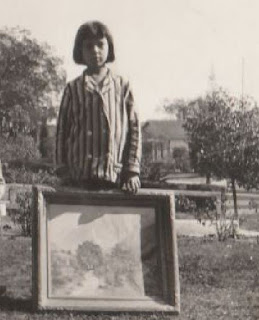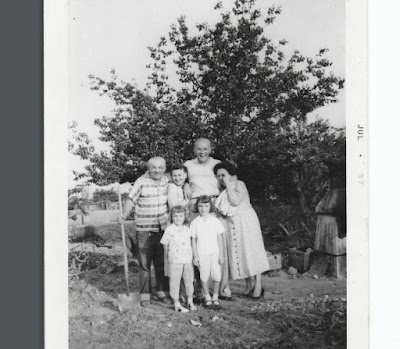Introduction
Most of the photos below were recently sent to me by an Aunt and I’m still trying to identify some of the people in them.
Another photo my family kept shows a little girl standing in the yard of a palm lined street. This little girl is named Mary Rita and she died as a child according to the back. Unfortunately there is no surname to identify her?
There is a shadow of a palm in this photo.
My mother Edna Forgey-Kapple's memory went back to California in the 1920's. She passed away in 2015. She often shared her early memories of California.
Her earliest memory was arriving at the port of Los Angeles in 1925. Her father was already in California and met her mother and herself at the dock with a Nicaraguan family friend. The Nicaraguan recently relocated to California and he asked my 4 year old mother if she remembered him, which she did.
1920’s thru 1930’s
The photo below was taken of my mother Edna soon after the family arrived in California in 1925. The palm trees remind me of a song about California. The song “Home In Pasadena“ lyrics talk about being “under the palms in someone’s arms”.
There is a shadow of a palm in this photo.
The family originally settled in bungalow court style housing in San Pedro. The photo below would have been taken in late 1926 after my aunt Grace was born. As you can see she was just learning to walk.

This photo appears to be a photo taken in front of a similar house. The rock pillars were a typical feature of California bungalows. Large rocks are numerous in the mountains near Glendale. The photo appears to be of my aunt Grace one of her twin brothers and aunt Dorothy. I enhanced the photo and colorized it at My Heritage.
Play dates were appear to have been popular with mothers and children spending time playing and chatting.

The family also loved taking a boat out to Catalina Island off the California coast.

Life was far from all play, during the Great Depression especially. My grandfather Charles Forgey worked as a carpenter when the family first arrived in California. During the early 30’s he trained to become a landscape gardener. He loved being outdoors, living in small houses with a large family I can understand why. He worked at some very posh residences during his gardening career in the Los Angeles area. Below you can see one of the houses he worked at through the trees.
When my grandfather Charles Forgey wasn't working he enjoyed painting. Below his wife and children are in front of their house with some of his paintings. He enjoyed photography also.
Underneath the normal appearances in the photos there was the ugly reality of the Great Depression followed by WWII.
As you can see from the photo below a distant Nicaraguan cousin hoped to make it big in show business someday. Here she is dressed for a hoped for movie role.
The Forgey boys were too young to serve in the military during WWII. Forgey family and friends did serve and sent their photos to the family.
The photo of uncles Charles and Cecil dressed as sailors was a portent of their future stint in the Navy.
Here I am in the snow as a child. Continuing the California tradition in the 1970's.
The photo below was likely taken at Venice, California where canals were dug to imitate the Venetian Canals. Spending time at the beach would have been nice for the family in the hot summers in California.
About 1928 my family relocated from the beach area to the hot dry San Fernando Valley. Sadly I don't think we have any photos of that first house. The photo below may have been taken in the yard of the house my grandfather built in La Cresenta.
Below is a photo of the entire Forgey brood somewhere in their new location home in the San Fernando Valley.
When the depression hit in 1929 the family lost the house and property and began renting houses in nearby Glendale. The house below is one of the houses the family rented in the 1930's. Blue collar working class workers generally lived in 2 bedroom 1 bath houses of about 900 or 1000 sq ft. Highly skilled blue collar workers could live in larger two story houses that were probably 1400 to 2000 sq ft. It was generally white collar workers who lived in the 2 story craftsman houses however. In the 1930’s apartments began to be popular with renters from working class families.
Here my mother Edna (in the print dress) is hanging out with her fellow girls scouts and her siblings. The blonde girl far left is the troop leader Bunny's daughter.
Friends of the Forgey family sporting the latest fashions sometimes appear in the family photos.
Someone called the "First Lady of Glendale" Dora Verdugo became a friend of the family in Glendale. Her family received a 36,000 acre Spanish land grant covering all of what today is Glendale. The photos below appear to have been given to our family by Dora. The portrait photo appears to be of her, and the group photo was likely taken near the old Verdugo homestead and adobe. Dora said her heart was always a part of that place.
The outings the family took from home were similar to the rest of the community. In Southern California we do something called "going to the snow" in winter. In many parts of the country the snow comes to you, but in most of California we have to go to the mountains to find it.
Many years the family would pack into their old model T and head to the beach. They would camp at Laguna beach and my grandfather would fish in nearby San Clemente.
The photos below show family and friends at the beach. Its interesting that the women are dressed up in heels on the beach.
The family would often join friends and family at the beach. The photo below appears to be of Francisco Alvarado Granizo and his wife Germaine taken in the 1920's or 1930's. Francisco was grandmother Graciela's cousin and godfather.
Picnicking was a popular pastime in early to mid century California. State themed picnics drew thousands of people. The Iowa picnic in Ontario and the All States picnic in Long Beach were very popular. I'm not sure where the picnic below took place or who sponsored it? The photo shows a typical park of that era and the Forgey children have grown from earlier photos.
The family could also travel farther north to Sequoia.
The photo of the women with the dogs may have been taken in a clients yard? My grandmother toured a kennel at a home my grandfather worked at and she said the dogs lived better than her family. Apparently the family was wealthy enough to provide a very comfortable roomy kennel for the dogs.
When my grandfather Charles Forgey wasn't working he enjoyed painting. Below his wife and children are in front of their house with some of his paintings. He enjoyed photography also.
My mother felt the stigma of many who received handouts meant to discourage people from seeking assistance. My mother told me that she received a coat given to people on relief and the coat made those wearing it stand out. I’m thinking the striped coat she has in this photo was probably what she was referring to? It would definitely make you conspicuous.
Some thought an easy way out of the difficult economic times for their families would be to get their children into show business. Many children in Glendale were enrolled in the Meglin Kiddies dance school. Children from that school often appeared in Our Gang shorts. 1940’s thru 1950’s
Around 1940 the Forgey family stopped renting houses in Glendale and purchased a house and some property in Puente, California (La Puente now). The Forgeys had enough land to start a small farm. Below the now older Forgey children, and friend, stand next to some of the crops.
Below is a photo of Aunt Grace and her date at the prom for El Monte High School students. She worked at a candy stand in Los Angeles in order to buy a formal dress.
Below the Forgey teens, and older sister and friend, line up in the traditional style in the Forgey yard.
Below my mother and grandfather sit in front of the Forgey family home in Puente. My Forgey grandparents owned the house for over 35 years.
Soon after the family moved to Puente WWII started. The economic situation improved but the rationing and blackouts made life challenging. My grandfather got a job working at Douglas Aircraft in shipping and receiving. He was able to afford to add an additional bedroom to the two room house.
Soon after the family moved to Puente WWII started. The economic situation improved but the rationing and blackouts made life challenging. My grandfather got a job working at Douglas Aircraft in shipping and receiving. He was able to afford to add an additional bedroom to the two room house.
Below the Forgey teens, and older sister and friend, line up in the traditional style in the Forgey yard.
The Forgey boys were too young to serve in the military during WWII. Forgey family and friends did serve and sent their photos to the family.
My grandfather continued his outdoor lifestyle continuing to garden, and sit in his favorite place on his front porch. He enjoyed hunting, fishing, and traveling to the High Sierras. Below he is in his yard caring for his extensive gun collection.
The California tradition of going to the snow continued after the move to the San Gabriel Valley. Here we see my aunts and uncles spending a day in the mountain snow.








































No comments:
Post a Comment